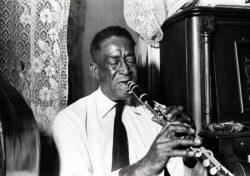Emile Barnes
Emile Barnes was a ragtime, early jazz, and brass band clarinetist from New Orleans, perhaps best remembered for his distinctive, blues-inflected sound and performance style.

Courtesy of Tulane University, William Ransom Hogan Archive of New Orleans Jazz
Emile Barnes. Crawford, Ralston (Photographer)
Emile Barnes was a ragtime, early jazz, and brass band clarinetist from New Orleans. Born into a highly respected musical family, Barnes is perhaps best remembered for his distinctive, blues-inflected sound and performance style. Although he was well known locally—a childhood friend of Sidney Bechet and a gifted player alongside a long list of jazz greats of the era—Barnes remained largely unknown outside New Orleans until the traditional jazz revival of the 1950s and 1960s, when he was featured on releases from both American Music Recordings and Folkways labels. His recorded collaboration with legendary multi-instrumentalist Peter Bocage, playing as the Barnes-Bocage Big Five, is highly regarded within the jazz canon. He was the older brother of Paul “Polo” Barnes, a noted jazz clarinetist.
Emile Barnes was born February 18, 1892, in New Orleans. His first instrument was a toy fife. He soon moved on to the flute, and then the clarinet, which was given to him by the great Bunk Johnson. Barnes studied more formally with Lorenzo Tio Sr., Alphonse Picou, and George Baquet. With them he gained technical skill while honing his own unique blues-tinged style.
Barnes soon became affiliated with Chris Kelly and signed on as clarinetist in the Chris Kelly Band, a partnership that would last until Kelly’s death in 1927. In the 1930s Barnes performed with “Wooden” Joe Nicholas’s Camellia Band; in the 1940s he performed with Kid Howard. During this time, Barnes also had standing gigs with Lawrence Toca at the Harmony Inn, a New Orleans venue, and with Billie and DeDe Pierce at Luthjen’s dancehall. As a brass band musician, Barnes performed with the Superior and Olympia Brass Bands, among others.
As is the case with many other musicians, Emile Barnes had to supplement income earned from his music career with other sources of employment. For much of his life, he handcrafted mattresses to support his family. Even so, Barnes left behind a large number of classic recordings that showcase his sound and style. In 1954 Barnes recorded an album released by the American label with the Barnes-Bocage Big Five, a popular group that included Peter Bocage, Albert Jiles (drums), Eddie Dawson (bass), and Homer Eugene (guitar). His 1952 recording for the Folkways studio was a mixed-race recording with Bill Huntington on banjo—an unlawful collaboration in an era of strict racial segregation. A February 24, 1953, a recording released by the Vogue label features Barnes with Albert Jiles, Harrison Brazlee, and British cornet player Ken Colyer at Barnes’s house on LaHarpe Street. This recording is also thought to be racially significant, as it is evidence of Colyer’s first experience with black New Orleans jazz musicians during an era of segregation.
Barnes’s last public performance at Preservation Hall was in 1963. He died in February 1970.
